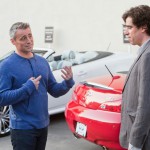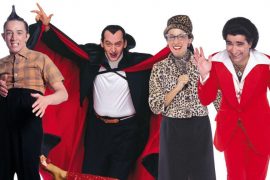OLIPHANT, Ont.–The news that Andy Griffith had died arrived like a dark cloud here at the unplugged cottage. Neighbour Jim got word off his satellite radio while listening to The Dan Patrick Show.
It was a perfect place to take it. Sheriff Taylor and Opie would be right at home up here, fishing poles in hand, a gentle summer breeze, that simple, infectious theme song whistling in the background.
Griffith’s Andy Taylor was an enduring original, a TV icon unlike any before or since. There was something so honest about Griffith and Ron Howard’s relationship on that show you could feel the connection, even (or maybe especially) if you were only Opie’s age when you first saw it.
It helped, of course, that there was something timeless and mythical about The Andy Griffith Show. Locked in that black and white time capsule, it does not seem like any part of the ‘60s conjured up today though Mad Men’s rear view mirror. Mayberry owed as much to Mark Twain as it did to Mt. Airy, the sleepy North Carolina town Griffith used as a blueprint for his folksy, small town comedy. (Griffith was never credited as a writer on the series, but every script apparently went through his typewriter.)
Then there was Griffithand Don Knotts, a perfect teeter totter between outrageously funny and real. The two made a final appearance at the TCA press tour maybe seven or eight years ago. (Might have been to promote one of those “Pioneers of Television” PBS broadcasts.) It was heartening was to see the great affection and respect the two had for each other.
 And we had for them. TV critics are cranky and bitter at the best of times but we’re all reduced to seven year olds when Andy, Barney, or any of our early TV heroes return for one last bow.
And we had for them. TV critics are cranky and bitter at the best of times but we’re all reduced to seven year olds when Andy, Barney, or any of our early TV heroes return for one last bow.My first encounter with Griffithdates back to my first press tours in the late ‘80s, when the then silver-haired actor was promoting NBC’s Matlock. The part of the folksy southern lawyer was Taylor-made for Griffith, rescued from two decades of oblivion after being typecast in his earlier comedy.
The rescuer was Fred Silverman, the savvy former NBC, ABC and CBS programming boss who knew Boomers weren’t ready to say goodbye to ‘60s and ’70s TV headliners like Griffith, Carrol O’Connor (resurrected in Silverman’s In The Heat of the Night), William Conrad (Jake ans the Fatman) and Dick Van Dyke (Diagnosis Murder) and others. Matlock ran nine seasons, one more than The Andy Griffith Show.
Several years ago I detoured off an Interstate on a drive back from Florida and ventured in to Mt. Airy. Griffith’s birthplace stands as monument to Mayberry. There is a museum where many of his mementos are kept, his early “What it Was, Was Football” comedy recordings, the white jacket he wore as Matlock.
I got my haircut at Floyd’s barbershop, not by Floyd (long deceased Howard McNear), but by an elderly barber who claimed to be the inspiration for the character. I was hoping it would have been Eugene Levy, who channelled Floyd to perfection on SCTV.
There is a Speedy Lunch café there, and I sampled the house specialty, a porkchop sandwich. There’s a guy who wears a Goober cap at the local gas station. Every year they have Mayberry Days, and hold contests to see who can best impersonate Otis, the town drunk.
It was strange to witness such devotion to a TV series decades after it went off the air. Important to remember just how popular the series was, ranking as TV’s most-watched show toward the end of its run with more viewers tuning in each week than watch an American Idol finale today. People laughed at Barney and Goober, but they wanted a slice of Aunt Bea’s pie and they wanted to go fishing with Andy and Opie. Griffith made it all real and stands as one of the greatest dramatic actors in a comedy ever.
That promise was there right in his first film role–1957’s A Face in the Crowd. His performance as a country boy who becomes a television monster seems more relevant in the Idol era than ever.






